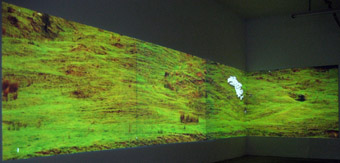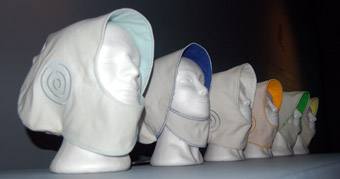magic and mistakes
somaya langley: isea 08, singapore

Composition for farmer, three dogs and 120 sheep, 2006, Alex Montieth
photo Somaya Langley
Composition for farmer, three dogs and 120 sheep, 2006, Alex Montieth
A SWELTERING FRIDAY MORNING IN SINGAPORE, AT THE WIND-UP OF THE 2008 INTERNATIONAL SYMPOSIUM ON ELECTRONIC ART (ISEA, DIRECTED BY GUNALAN NADARAJAN), IS WHEN I CHOOSE TO HEAD TOWARDS COOLER GALLERY SPACES. THIS YEAR, AMONGST DOZENS OF ARTISTS PRESENTATIONS, SEVERAL PERFORMANCES, ROUNDTABLE WORKSHOPS, NIGHT-TIME GIGS AND KEYNOTE SPEECHES, THE SYMPOSIUM PLAYED HOST TO FIVE GALLERY EXHIBITIONS. AUSTRALIA AND NEW ZEALAND ARE WELL REPRESENTED BY EXPERIMENTA PLAY++ AND CLOUDLAND: DIGITAL ART FROM AOTEAROA (CURATED BY SU BALLARD, STELLA BRENNAN AND ZITA JOYCE). OTHERS WERE LUCID FIELDS—MEDIA ARTWORKS BY SWISS ARTISTS-IN-LABS, MALAYSIAN DIGITAL ARTS ON DISPLAY IN RELOCATIONS AND THE MAIN ISEA 2008 JURIED EXHIBITION SITUATED INSIDE THE GLARING WHITE EXTERIOR OF THE NATIONAL MUSEUM OF SINGAPORE.
video simplicity
On entering Cloudland I’m mesmerised by Alex Monteith’s Composition for farmer, three dogs and 120 sheep (NZ, 2006) for four-channel video installation. The beauty and simplicity of this work are immediately apparent yet, unlike the majority of video works in gallery spaces, it has me sitting on the floor within minutes, and remaining for over half an hour. As I observe the herd of sheep traverse the wide multi-channel projection—which is angled into a gallery corner—I’m aware that only the barking of the dogs and the sound of the farmer’s whistles accompany this imagery. Such sounds repeated at length, have the potential to annoy, instead here they transport the viewer into a zone—perhaps not directly into the landscape of the work itself—but definitely far away from the gallery walls and the humidity of Singapore lurking outside. This is partly achieved by the decision to project in a wedge configuration, allowing the audience to gain an overall perspective and immerse themselves in the work. Ultimately these choices enhance the captivating nature of this video work.
installation exclusion
At the opposite end of the small gallery space is et al.’s the social meaning of things (NZ, 2008). While Monteith’s Composition for farmer… openly offers a viewing experience, et al.’s work is uninviting, and most likely this is intentional. Caged behind two temporary six-foot wire fences is a mundane scene comprising a white plastic garden chair and a desk with laptop displaying a (seemingly hostile) three-dimensional game environment that is also duplicated on the wall behind. What looks boring becomes captivating the closer you shift towards it. It’s a work very much situated in the context of the political and social critique of border issues and inhumane confinement. It has the potential to draw the audience in, while simultaneously distancing them. But without socio-political reference points the installation and the fences could block the experience entirely.
intimate interfaces
In the even cooler depths of the National Museum of Singapore, the 16 works on display in the ISEA juried exhibition—comprising multiple installations and audio-visual projections—demand more than a single day of viewing. The show is the result of the ISEA 2008 Artist in Residence program, where some 20 artists were based in university laboratories and departments around Singapore in the three-month lead-up to the symposium.
Several works remain prominent in my memory, including Gender Strategies for Loitering (Shilpa Phadke, Shilpa Ranade and Sameera Khan, India, 2008) which focuses on gender inequalities in India and Singapore. In both it is socially acceptable for men to loiter in public space without question, yet respectability is stripped from any woman who chooses to do the same. Also appealing were Momoyo Torimitsu’s Smile, Wear it Like a Costume! (Japan/USA, 2008) based on research into the interpretations of the smile carried out in collaboration with the National University of Singapore Face Group, and Clea T Waite’s The Water Book (An Encyclopedia of Water) (USA/Germany, 2008) with its exquisite water touch interface I mistook for a glass tabletop, almost dropping my camera into the depths. In The Water Book, light projected words appear in the water acting as touchable hotspots for triggering video play back.

We Hear One Another, 2008, Kelly Jaclynn Andres
photo Somaya Langley
We Hear One Another, 2008, Kelly Jaclynn Andres
Kelly Jaclynn Andres’ Finally, We Hear One Another (Canada, 2008) is a wearable sound-oriented work designed for pairs of participants. With hood-like bonnets, each audience member wishing to take part in the experience partners up, hoods up and is then able to wander through the museum. A cone, containing a microphone, positioned at the back of the bonnet, is used to transmit audio to the other participant, permitting the wearer to experience the sound world of their partner. While conceptually poetic, this work breaks down the moment you are handed a mobile phone to hold during your sonic exploration. Finally, We Hear One Another exposes the difficulty of media art attempting (and rightly so) to reach beyond the typical plastic and metal interfaces we’re so accustomed to having mediate our experience. Once the cover comes off or the tech falls out of its custom-designed pocket, the illusion bursts and we’re often left holding some gadget with a mass of cables attached.
Standing back to watch a couple of young girls explore the space with this wearable work rejuvenated my initial attraction. Positioned in different parts of the gallery, but not too far away from each other, they were asking loudly “can you hear me, can you hear me…”. Taking the work at face value, without filtering it through an analytical framework, their genuine playfulness and engagement proves, that while they are probably familiar with the underlying technology, this repositioning brings with it actual intrigue.
controller/performer
The sound of a gamelan orchestra permeates the entire exhibition space, and it’s not until I wander into the dedicated Quartet room, that the full effect is felt. Using what I can only assume is a custom-developed gesture recognition system, Tad Ermitano provides the opportunity to conduct a robotic gamelan orchestra by means of various poses. An instructional video helps you to quickly learn some of these hand and arm gestures before stepping up to the conductor’s platform. While the work blends some seemingly unauthentic components (the notion of a traditional western conductor married with a gamelan orchestra for instance), the fun increased the more you conducted. Other members of the audience often stayed in the space for extended periods, observing the odd gestures of the spotlit individual.
challenges
The works in the ISEA 2008 juried exhibition raised more questions about their effectiveness than the significance of their content and the issues they posed. Despite intensive development periods and the complete dedication of the artists, technology can become a barrier, making the audience’s ability to engage difficult. Perhaps this raises broader issue of art, science and technology collaborations in research environments with restricted time frames. In the catalogue, the majority of these artworks read as exceptional. Yet ‘in the flesh’, despite clean production and presentation, their magic was often broken with problems evident in the underlying (sometimes hacked) technological platform coming to the fore.
While the overall curation and layout of the juried exhibition was magnetic, individual works often appeared as a ‘show and tell’ of research outcomes. One particular downside was the over-reliance on traditional video projection and screen display, diminishing other components. The Water Book interface is astounding in itself, but its triggering of video only disappoints. These days, I want the artwork to capture me on an intimate and personal level. For this reason, less tech-heavy works in the Cloudland exhibition, provided ultimately more engaging and rewarding experiences.
ISEA 2008, International Symposium on Electronic Art, director Gunalan Nadarajan, various venues, Singapore, July 25-Aug 3, 2008, www.isea2008singapore.org
RealTime issue #88 Dec-Jan 2008 pg. 28






